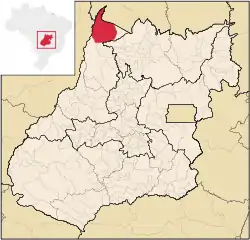São Miguel do Araguaia
São Miguel do Araguaia is a city in northeastern Goiás state, Brazil. It is the northernmost municipality in Goiás, one of the largest too, and a major producer of cattle.
São Miguel do Araguaia | |
|---|---|
Municipality | |
| The Municipality of São Miguel do Araguaia | |
 Flag  Seal | |
 Location of São Miguel do Araguaia in Goiás | |
| Coordinates: 13°17′20″S 50°09′15″W | |
| Country | |
| Region | Central-West |
| State | |
| Founded | November 14, 1958 |
| Government | |
| • Mayor | Ademir Cardoso dos Santos |
| Area | |
| • Total | 6,144.380 km2 (2,372.358 sq mi) |
| Elevation | 378.08 m (1,240.42 ft) |
| Population (2020 [1]) | |
| • Total | 21,920 |
| • Density | 4.1/km2 (11/sq mi) |
| Time zone | UTC-3 (UTC-3) |
| • Summer (DST) | UTC-2 (UTC-2) |
| HDI (2000) | 0.737 – medium[2] |
São Miguel is located in the São Miguel do Araguaia Microregion and is one of the most distant cities from the state capital, Goiânia, which is 486 kilometers away. There are highway connections with Araguaçu, state of Tocantins, 63 kilometers to the north; Nova Crixás, 102 kilometers to the south; and the district of Luís Alves, 45 kilometers to the west, on the Araguaia River.
Highway connections are made from Goiânia by GO-070 / Goianira / Inhumas / Itaberaí / BR-070 / Goiás / GO-164 / Araguapaz / Nova Crixás.
History
The region received its first settlers in 1952 with the arrival of José Pereira do Nascimento, Lozorik Belem, and Ovídio Martins de Souza who bought large areas of land and began to raise cattle. José Pereira do Nascimento was a Spiritualist healer and attracted people seeking a cure for their ills. Soon a small settlement began to grow on the banks of the São Miguel River, called São Miguel. Soon the government surveyed the land and demarcated lots for distribution to new farmers coming from the south of the state of Minas Gerais. In 1958 it passed directly from district to municipality with its present name. The greatest period of growth was in the 1960s when thousands of settlers arrived from the south of the country receiving free land to settle in the region.
In 2007 the urban population was 18,202 while the rural population was 4,266. The population growth rate from 1996/2007 was 0.56%. There was a gain of about 2,200 people since 1980.
The economy is based on subsistence agriculture, cattle raising, services, public administration, and small transformation industries. The cattle herd is one of the largest in the state. Most of the farm land is used for cattle raising. In 2007 there were 21 industrial units and 221 commercial units. There were 06 banks.
- Farms: 1,005
- Total agricultural Area: 524,580 hectares
- Permanent Planted Area: 192 hectares
- Perennial Planted Area: 1,027 hectares
- Natural Pasture: 411,405 hectares
- Woodland and Forest: 108,622 hectares
- Workers related to the farm owner: 2,224
- Workers not related to the farm owner: 707 (IBGE)
- Cattle herd: 483,000 head (2006)
- Main crops: rice (1,400 hectares) corn (700 hectares), and soybeans (1,000 hectares). (All data are from IBGE 2006)
Education
In the educational sector there were 21 schools with 6,684 students (2006). Higher education was represented by the UEG - Faculdade de Educação, Agronomia e Veterinária de São Miguel do Araguaia. The adult literacy rate was 83.1% (2000) (national average was 86.4%). In the health sector there were 04 hospitals with 92 beds (2007). The infant mortality rate was 25.62 (2000) (national average was 33.0)
Tourism
Tourism is concentrated in the settlement of Luís Alves on the Araguaia River, where there are several small hotels. The population of 800 grows to 30,000 in the months of June and July when the waters of the river go down, revealing kilometers of white sands.
In 2000 São Miguel was ranked 0.737 on the United Nations Human Development Index and was 120 out of 242 municipalities in the state. It was 2,257 out of 5,507 municipalities in the country. (All data are from 2000). For the complete list see Frigoletto.com. On the Seplan Economic Development Index the ranking was 139 out of 246 municipalities. See Seplan. On the Seplan Social Development Index the ranking was 175 out of 246 municipalities. See Seplan
